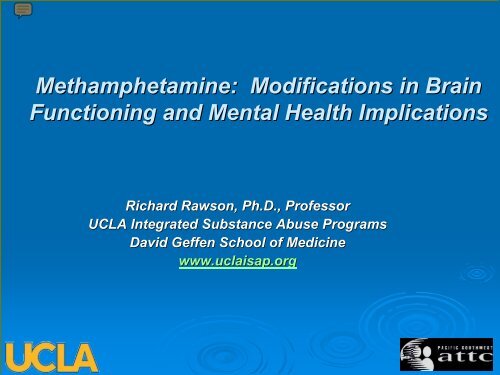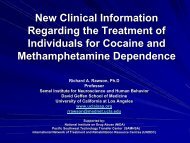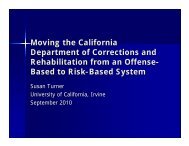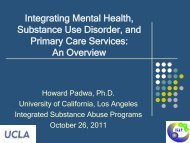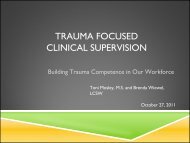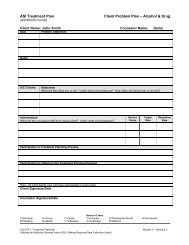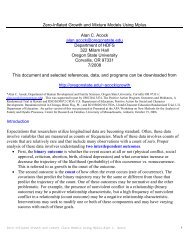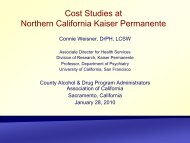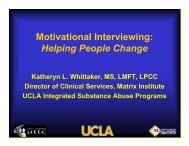Methamphetamine - UCLA Integrated Substance Abuse Programs
Methamphetamine - UCLA Integrated Substance Abuse Programs
Methamphetamine - UCLA Integrated Substance Abuse Programs
You also want an ePaper? Increase the reach of your titles
YUMPU automatically turns print PDFs into web optimized ePapers that Google loves.
<strong>Methamphetamine</strong>: Modifications in BrainFunctioning and Mental Health ImplicationsRichard Rawson, Ph.D., Professor<strong>UCLA</strong> <strong>Integrated</strong> <strong>Substance</strong> <strong>Abuse</strong> <strong>Programs</strong>David Geffen School of Medicinewww.uclaisap.org
Scope of the ATS ProblemWorldwide‣ According to surveys and estimates by WHOand UNODC, ATS is the most widely usedcategory of illicit drugs in the world except forcannabis.‣ World wide it is estimated there are over 26million regular users of amphetamine,methamphetamine, or ecstasy, as compared toapproximately 16 million heroin users and 14million cocaine users.‣ <strong>Methamphetamine</strong> accounts for over 90% of theATS used worldwide
Respiratory Disorders and MA Use‣ Pulmonary edema‣ Bronchitis‣ Pulmonary hypertension‣ COPD
Why do people take drugs?To feel goodTo have novel:FeelingsSensationsExperiencesANDTo share themTo feelbetterTo lessen:AnxietyWorriesFearsDepressionHopelessnessWithdrawal
In other words:A Major Reason PeopleTake a Drug is they LikeWhat It Does to Their Brains
What parts of the brain are wetalking about?
Meth
Meth
dopaminereservoirsynapse
In other words…BrainsTheir have beenRe-Wiredby Drug Use
Prolonged Drug Use ChangesThe Brain In Fundamental andLong-Lasting Lasting Ways
% of Basal DA Output200150100500EmptyFOODBox FeedingNatural Rewards ElevateNAc shell0 60 120 180Time (min)Dopamine LevelsDA Concentration (% Baseline)200150100ScrScrBasFemale 1 PresentSEXScrScrFemale 2 PresentSample11 22 33 44 55 66 77 88 99 10 11 12 13 14 15 16 17NumberMountsIntromissionsEjaculations151050Copulation FrequencySource: Di Chiara et al.Source: Fiorino and Phillips
Effects of Drugs on Dopamine Release% Basal Release15001000500AccumbensMETHAMPHETAMINE% of Basal Release400300200100AccumbensCOCAINEDADOPACHVA00 1 2 3hrTime After <strong>Methamphetamine</strong>00Time After Cocaine% of Basal Release2502001501000000 11 22 3 hrTime After NicotineNICOTINEAccumbensCaudate% of Basal Release2502001501000AccumbensETHANOLDose (g/kg ip)0.250.512.50 1 2 3 4hrTime After EthanolSource: Shoblock and Sullivan; Di Chiara and Imperato
Decreased dopamine transporterbinding in METH users resembles thatin Parkinson’s s DiseaseControl Meth PDSource: McCann U.D.. et al.,Journal of Neuroscience, 18, pp. 8417-8422, October 15, 1998.
Control> MA43210
MA >Control543210
Labeling of EmotionBrain scans were takenwhile people answeredthe question below lookingat the following What did picturestheir brainsshow?Which of the two bottom picturesmatches the emotion shown on top?
Control Subjects and<strong>Methamphetamine</strong> <strong>Abuse</strong>rs ActivateEmotion &Face Processing AreasControl<strong>Methamphetamine</strong>amygdalaamygdalaD Payer et al., Abstr. Soc. Neurosci., 2005
How muchdoes the brain heal?
PET Scan of Long-Term Meth Brain Damage
Partial Recovery of Brain DopamineTransporters in <strong>Methamphetamine</strong> <strong>Abuse</strong>rAfter Protracted Abstinence30ml/gmNormal ControlMETH <strong>Abuse</strong>r(1 month detox)METH <strong>Abuse</strong>r(24 months detox)Source: Volkow, ND et al., Journal of Neuroscience 21, 9414-9418, 2001.
Brain Serotonin TransporterDensity and Aggression inAbstinent <strong>Methamphetamine</strong><strong>Abuse</strong>rs **Sekine, , Y, Ouchi, , Y, Takei, N, et al. Brain Serotonin Transporter Densityand Aggression in Abstinent <strong>Methamphetamine</strong> <strong>Abuse</strong>rs. Arch GenPsychiatry. 2006;63:90-100.
<strong>Methamphetamine</strong> Use, Self-Reported Violent Crime, andRecidivism Among Offenders inCalifornia Who <strong>Abuse</strong> <strong>Substance</strong>s*Cartier J, Farabee D, Prendergast M. <strong>Methamphetamine</strong> Use, Self-ReportedViolent Crime, and Recidivism Among Offenders in California Who <strong>Abuse</strong><strong>Substance</strong>s. Journal of Interpersonal Violence. 2006;21:435-445.445.
Results‣ Those who used MA (81.6%) weresignificantly more likely than those whodid not use MA (53.9%) to have beenreturned to custody for any reason or toreport committing any violent acts in the30 days prior to follow-up (23.6% vs.6.8%, respectively)
Neural Activation Patterns of<strong>Methamphetamine</strong>-DependentSubjects During Decision MakingPredict Relapse **Paulus M, Tapert S, Schuckit M. Neural Activation Patterns of<strong>Methamphetamine</strong>-Dependent Subjects During Decision MakingPredict Relapse. Arch Gen Psychiatry. 2005;62:761-768.768.
Results‣ 18 of 40 subjects relapsed‣ Bilateral prefrontal cortex, striatum,posterior parietal cortex, and anteriorinsula were more active during theprediction task than the response task
Results Continued‣ 9 areas within these regions differentiatedrelapsing and nonrelapsing participants• Areas included prefrontal, parietal, and insularcortex• Nonrelapsing individuals showed moreactivation in these areas
Results Continued• Right insula, right posterior cingulate, andright middle temporal gyrus response bestdifferentiated between relapsing andnonrelapsing participants• Cross-validation analysis was able to correctlypredict 19 of 22 who did not relapse and 17 of 18who relapsed• Right middle frontal gyrus, right middletemporal gyrus, and right posterior cingulatecortex activation best predicted time torelapse
Implications of Results• Neural activation differences are part of asystem involved with the processing ofdecision making. Attenuated activation mayrepresent:• Defective assessment abilities and subsequentreliance on habitual behaviors• Diminished ability to differentiate choices that leadto good vs. poor outcomes• fMRI may prove to be a useful clinical tool toassess relapse susceptibility
<strong>Methamphetamine</strong>Psychiatric Consequences‣ Paranoid reactions‣ Long term memory loss‣ Depressive reactions‣ Hallucinations‣ Psychotic reactions‣ Panic disorders‣ Rapid addiction
Acute MA Psychosis‣ Extreme Paranoid Ideation‣ Well Formed Delusions‣ Hypersensitivity to Environmental Stimuli‣ Stereotyped Behavior “Tweaking”‣ Panic, Extreme Fearfulness‣ High Potential for Violence
Treatment of MA Psychosis‣ Typical ER Protocol for MA Psychosis:• Haloperidol - 5mg• Or, atypical antipsychotic (eg(eg.respiridone)• Clonazepam - 1 mg• Cogentin - 1 mg• Quiet, Dimly Lit Room• Restraints
MA Psychosis Inpatients from 4 CountriesPsychotic symptomPersecutory delusionAuditory hallucinationsStrange or unusual beliefsThought readingVisual hallucinationsDelusion of referenceThought insertion or made actNegative psychotic symptomsDisorganized speechDisorganized or catatonic behaviorNo. of patients havingsymptoms (%)Lifetime130 (77.4)122 (72.6)98 (58.3)89 (53.0)64 (38.1)64 (38.1)56 (33.3)Current35 (20.8)75 (44.6)39 (23.2)27 (16.1)38 (22.6)20 (11.9)18 (10.7)36 (21.4)19 (11.3)14 (8.3)Srisurapanont et al., 2003
MA Psychosis‣ 69 physically healthy, incarcerated Japanesefemales with hx MA use• 22 (31.8%) no psychosis• 47 (68.2%) psychosis• 19 resolved (mean=276.2±222.8 222.8 days)• 8 persistent (mean=17.6±10.5 10.5 months)• 20 flashbackers (mean=215.4±208.2 208.2 days to initialresolution)• 11 single flashback• 9 Recurrent flashbacks Yui2001Yui et al.,‣ Polymorphism in DAT Gene associated with MApsychosis in JapaneseUjike et al., 2003
MAT-SS Psychiatric andMedical Studies
Scope of Work‣ Study 1: Epidemiology of Psychiatric Illness‣ Study 2: Clinical Course and Outcomes of MA userswith Major Depressive Disorder‣ Study 3: Clinical Course and Outcomes of MA userswith Psychotic Disorders‣ Study 4: Risk Factors for Depression‣ Study 5: Risk Factors for Suicide Attempts‣ Study 6: Medical Illness in MA users at Follow-Up
Study I: Epidemiology of Psychiatric IllnessGlasner-Edwards, S., Mooney, L.J., Marinelli-Casey, P., Hillhouse, M., Ang, A., &Rawson, R. (under review). Psychopathology in methamphetamine dependentadults 3 years after treatment.‣ Aims• To characterize prevalence of psychiatric illness in MAdependent adults 3 years post-treatmenttreatment• To examine association of psychiatric illness withtreatment retention and outcomes at 3-year 3follow-up‣ HypothesisPsychiatric diagnoses and severity will be associated withpoorer treatment retention and outcomes.‣ Measures• Mini-International Neuropsychiatric Interview, ASI, BSI
Results: Psychiatric Diagnoses (N=526)Diagnosis Current (%) Life (%)Any Psychiatric Disorder 34.0 34.6Affective DisordersMajor Depression 15.2 ***Major Depression, Recurrent *** 9.1Mania 3.9 8.5Hypomania 2.4 9.3Any Affective Disorder 22.2 24.5Any Anxiety Disorder 23.4 ***Psychotic Disorders 4.9 12.7Antisocial Personality Disorder *** 25.8
Association of Diagnoses with Outcomes‣ MA use• Those with an Axis I disorder reported greater frequency of MA use uduring FU compared to those without a diagnosis, t(523)= -2.0,p=0.03.• MA use frequency during FU increased as a function of the number ofpsychiatric diagnoses (β=0.68,(SE=0.29, p=0.02).‣ Other psychosocial and functional outcomes• Those with an Axis I disorder evidenced problems of significantlygreater severity from baseline to FU on a subset of ASI compositesand BSI scales:• ASI: Alcohol, drug, psychiatric• BSI: anxiety, phobic anxiety
‣ HypothesesStudy II: Major Depressive DisorderGlasner-Edwards, S., Marinelli-Casey, P., Hillhouse, M., Ang, A., Mooney, L.J., &Rawson, R. (under review). Depression among methamphetamine users:association with outcomes from the MTP at 3-year follow-up.• Depressive symptoms will decline during tx, , an effect thatwill vary as a function of MA use• Depression diagnoses and severity will be associatedwith poorer adherence and outcomes‣ Measures• Mini-International Neuropsychiatric Interview• Life Experiences Timeline (LET)• BDI, ASI, BSI (at baseline, discharge, and 3-yr 3FU)
Results: Major Depressive DisorderResults: Major Depressive Disorder0.60.5No MDDBaselineDischargeFollow-up0.40.30.20.10.0medicalemploymentalcoholdruglegalfamilypsychiatricASI CompositeMean Composite Score
Results: Major Depressive DisorderResults: Major Depressive Disorder0.60.5MDDBaselineDischargeFollow-Up0.40.30.20.10.0medicalemploymentalcoholdruglegalfamilypsychiatricASI CompositeMean Composite Score
‣ HypothesesStudy III: Psychotic DisordersGlasner-Edwards, S., Mooney, L.J., Marinelli-Casey, P., Hillhouse, M., Ang, A., &Rawson, R. (in press). Clinical course and outcomes of methamphetaminedependent adults with psychosis. Journal of <strong>Substance</strong> <strong>Abuse</strong> Treatment.• Psychotic disorders will be associated with greaterfunctional impairment and healthcare service utilizationrelative to MA users without psychotic illness.• The presence of a psychotic disorder will predict poorerMA use outcomes.‣ Measures• Mini-International Neuropsychiatric Interview• Life Experiences Timeline (LET)• ASI, BSI (at baseline, discharge, and 3-yr 3FU)
Results: Psychotic Disorders• 12.9% of the sample was diagnosed with a psychotic disorder(current or past).• Those with psychotic illness were more likely to have beenhospitalized within the year prior to FU than those without a diagnosis(OR=2.4, 95% C.I., 1.2-4.3) and reported more episodes (β=0.33,(SE=0.11, p
‣ AimStudy IV: Risk Factors for DepressionGlasner-Edwards, S., Mooney, L.J., Marinelli-Casey, P., Hillhouse, M., Ang, A., &Rawson, R. (in press). Identifying methamphetamine users at risk for majordepressive disorder: findings from the MTP at 3-year follow-up. Am J Addictions.• To characterize baseline clinical, demographic, and substance usecharacteristics that predict post-treatment treatment MDD.‣ Candidate risk factors included• Female gender• Route of MA administration• Alcohol dependence• History of suicide attempts or serious depression• Clinically significant depressive sx’s at baseline (BDI > 20)• Family hx psychiatric problems• Lifetime hx physical or sexual abuse
MDD Risk FactorsRisk FactorOddsRatio95% C.I. pBDI>20 2.21 1.23-3.993.99 *0.008Gender (%women) 1.30 0.79-2.400.398Route ofadministration (% IV)1.20 0.66-2.180.531EtOH treatment hx 1.56 0.84-2.900.151SAs (lifetime) 2.42 1.32-4.44*0.004Depression (lifetime) 1.49 0.78-2.840.221
‣ AimStudy V: Risk Factors for Suicide AttemptsGlasner-Edwards, S., Mooney, L.J., Marinelli-Casey, P., Hillhouse, M., Ang, A., &Rawson, R. (2008). Risk factors for suicide attempts in methamphetaminedependent patients. Am J Addictions, 17: 24-27.• To identify risk factors for suicide attempts in MA dependent patients.‣ Candidate risk factors included• Female gender• Route of MA administration (injector vs. non-injector)• Prior tx for alcohol- or drug-related related problems• History of serious depression• Clinically significant depressive symptoms at baseline• Family hx psychiatric illness in first-degree relatives• Lifetime hx physical or sexual abuse• Prior psychiatric hospitalizations• Lifetime years of MA use
Predictors of SA‣ 28.7% (n=151) of MA dependent patients atfollow-up had attempted suicide in their lifetime‣ After controlling for age, marital status,education and lifetime MA use, five risk factorsfor lifetime SA included:• BDI>20 (OR=1.8, 95% C.I., 1.1-2.9)• Female gender (OR=2.0, C.I., 1.1-3.6)• IV use (OR=2.2, C.I., 1.2-3.9)• Psychiatric admission hx (OR=1.7, C.I., 1.2-2.3)2.3)• Serious depression hx (OR=3.1, C.I., 1.7-5.4)
Study VI: Medical Illness in MA UsersMooney, L.J., Glasner-Edwards, S., Marinelli-Casey, P., Hillhouse, M., Ang, A.,Ling, W., & Rawson, R. (in preparation). Medical illness in methamphetamineusers 3 years after treatment.‣ Aims• To characterize the prevalence of medical problems in methamphetamineamineusing populations.• To describe the nature and extent of the association between medicalconditions and post-treatment treatment MA use frequency.• To determine the relationship between route of administration and d medicaloutcomes.‣ Hypothesis• Injection use will be associated with higher rates of medical comorbidity.‣ Measures• Health Status Survey• Physical Exam• EKG• Laboratory data
Study VI: Preliminary Findings‣ Frequencies of Lifetime Medical Problems (N=301)• Hypertension: 19%• Wounds and Burns: 45%• Hepatitis: 14.6%• Dental problems: 33%‣ EKG abnormalities• QTc prolongation: 18.5%‣ Relationship of lifetime medical Problems to MA use during follow-up‣ Association of injection use with medical problems• Hypertension (OR: 1.9; 95% C.I., 0.9-3.6)• Hepatitis (OR: 16.0; 95% C.I., 6.7-39.0)• Kidney/bladder problems (OR: 2.0, 95% C.I., 1.0-3.9)• Dental problems (OR: 2.4, 95% C.I., 1.3-4.2)• Wounds/Burns (OR: 2.5, 95% C.I., 0.9-6.5)• STDs (OR: 2.6, 95% C.I., 1.0-6.8)• Sleep problems
Prenatal Meth. Exposure‣ Preliminary findings on infants exposedprenatally to methamphetamine (MA) andnonexposed infants suggest:• Prenatal exposure to MA is associated with anincrease in SGA (Small-forfor-Gestational-Age).• Neurobehavioral deficits at birth were identified inNNNS (Neonatal Intensive Care Unit NetworkNeurobehavioral Scale) neurobehavior, includingdose response relationships and acoustical analysisof the infant’s s cry (Lester et al., 2005).
Adolescent Meth. <strong>Abuse</strong>Treatment Admissions‣ Matrix(Boys)(Girls)• 2002 16% 63%• 2003 25% 67%• 2004 22% 69%‣ Phoenix (Boys)(Girls)• 2002 25% 43%• 2003 23% 51%• 2004 27% 53%
My Sexual Pleasure isEnhanced by the use of:Percent Responding"Yes"100908070605040302010016.0 18.238.224.444.711.173.566.7opiates alcohol cocaine methmalefemalePrimary Drug of <strong>Abuse</strong>(Rawson et al., 2002)
My Sexual Performance isImproved by the use of:Percent Responding"Yes"100908070605040302010019.115.932.424.418.411.158.8 61.1opiates alcohol cocaine methmalefemalePrimary Drug of <strong>Abuse</strong>(Rawson et al., 2002)
Behavior Symptom Inventory(BSI) Scores at Baseline1.601.40all significant at p< .0011.20FemaleMale1.000.800.600.400.200.00SomatizationObsessive-CompulsiveInterpersonal SensitivityDepressionAnxietyHostilityPhobic AnxietyParanoid IdeationPsychoticismMean BSI Score
BSI PsychiatricSymptoms by Route30Positive Symptom Total (PST)2520151050IN SM IDUBL PSTTX-End PST6-Mo PST12-Mo PSTP
Hepatitis C by Route50454440% Prevelance35302520151215IN (n=99SM (N=478)IDU (n=146)Total (n=723)10750P
Can <strong>Methamphetamine</strong> Users beSuccessfully Treated?Successful treatment of methamphetamine (MA) usersemploys many elements in common with treatmentstrategies for other groups of drug users.There is no evidence that MA users have poorer outcomesthan other groups of drug users.However, with attention to some specific clinical issues andapplication of some specific clinical strategies, treatmentoutcomes can be substantially improved.
Clinical Challenges with <strong>Methamphetamine</strong>Dependent Individuals‣ Limited Understanding of Addiction‣ Cognitive Impairment‣ Anhedonia‣ Sexual Reactivity and Meth Craving‣ Elevated Potential for Violence‣ Persisting “Flashbacks”ofMeth Paranoia‣ Sleep Disorders‣ Poor Retention in Outpatient Treatment‣ Elevated Rates of Psychiatric Co-morbidity
Special treatment consideration should bemade for the following groups of individuals:‣ Female MA users (higher rates of depression; very high rates ofprevious and present sexual and physical abuse; responsibilities forchildren).‣ Injection MA users (very high rates of psychiatric symptoms; severeerewithdrawal syndromes; high rates of hepatitis).‣ MA users who take MA daily or in very high doses.‣ Homeless, chronically mentally ill and/or individuals with high levels ofpsychiatric symptoms at admission.‣ Individuals under the age of 21.‣ Gay men (at very high risk for HIV and hepatitis).
Why the “MA treatment doesn’twork” perceptions?‣ Many of the geographic regions impacted by MA do nothave extensive treatment systems for severe drugdependence.‣ Medical and psychiatric aspects of MA dependenceexceeds program capabilities.‣ High rate of use by women, their treatment needs andthe needs of their children can be daunting.‣ Although some traditional elements may be appropriate,many staff report feeling unprepared to address many ofthe clinical challenges presented by these patients
Meth Treatment StatisticsDuring the 2005-2006 2006 fiscal year:‣ 42,206 individuals were admitted totreatment in California under the <strong>Substance</strong><strong>Abuse</strong> and Crime Prevention Act funding.‣ Of this group, 53% reported MA as theirprimary drug problem
StatisticsAnalysis of:‣ Drop out rates‣ Retention in treatment rates‣ Re-incarceration rates‣ Other measures of outcomeAll these measures indicate that MA usersrespond in an equivalent manner asindividuals admitted for other drug abuseproblems.
Comparability of Treatment Outcome: Cocaine vs<strong>Methamphetamine</strong>‣ Huber, Ling and Rawson (Jnl(of AddictiveDiseases, 1997).‣ Cohorts of methamphetamine dependentpatients (N=500) and cocaine dependentpatients (N=224) treated with a standardized,outpatient treatment protocol (Matrix Model) atthe same clinic site, by the same staff over thesame time period, demonstrated very similartreatment response on virtually all treatmentparticipation and outcome measures
MA Treatment Issues‣ Acute MA Overdose‣ Acute MA Psychosis‣ MA “Withdrawal”‣ Initiating MA Abstinence‣ MA Relapse Prevention‣ Protracted Cognitive Impairment andSymptoms of Paranoia
Priorities are:Management of OverdoseReactions‣ maintain airway, circulation, breathing‣ control elevated body temperature(hydration, cold water, ice)‣ control seizures (IV diazepam)‣ manage psychotic symptoms (antipsychotics)‣ reassurance, support, comfort, minimal stimulation.Treatment depends on patient’s s condition on presentation.
Psychostimulant WithdrawalCrash(Days 1–3) exhaustion depression oversleeping no cravingsPeak symptoms(Days 2–10) dysphoria lack energy increased appetite generalised achesand pains re-emergence ofmild psychoticfeatures, including:misperceptionsparanoid ideationhallucinationsanxiety. sleeplessness high cravingResidual symptoms(from 1–16 weeks) episodic craving insomniaFluctuating: irritability agitation restlessness dysphoria lethargy amotivation
Withdrawal TreatmentImmediate withdrawal treatment• setting, (outpatient, or inpatient)• supportive environment, information and reassurance• provide ongoing monitoring• plan long term management strategiesPlanning for prolonged withdrawal• anticipate it will be prolonged(i.e. affecting sleep, mood, cravings)• plan for lapse and relapse
Pharmacotherapies for PsychostimulantWithdrawal‣ Aim to decrease discomfort‣ Benzodiazepines• assist sleep or reduce anxiety andagitation• avoid long term prescribing‣ Antipsychotics and Antidepressants• available research shows limitedefficacy.
Promising Pharmacotherapies?‣ Newton, T. et al (Biological Psychiatry, Dec, 2005)Bupropion reduces craving and reinforcing effects ofmethamphetamine in a laboratory self-administrationstudy.‣ Elkashef, A. et al (Neuropsychopharmcology(Neuropsychopharmcology, , 2007)Bupropion reduces meth use in an outpatient trial,with particularly strong effect with less severe users.‣ Tiihonen, , J. et al (recently completed; reported at theACNP methamphetamine satelite meeting in Kona,Hawaii) Methylphenidate SR (sustained release) hasshown promise in a recent Finnish study with veryheavy amphetamine injectors.
Initiating MA Abstinence‣ Key Clinical Issues:• Depression• Cognitive Impairment• Continuing Paranoia• Anhedonia• Behavioral/Functional Impairment• Hypersexuality• Conditioned Cues• Irritability/Violence
Treatments for Stimulant-UseDisorders with EmpiricalSupport‣ Motivational Interviewing‣ Cognitive-Behavioral Therapy (CBT)‣ Community Reinforcement Approach‣ Contingency Management‣ Matrix Model
Treatment Resources‣ Methamphetmine Practionner’s s Guide• www.uclaisap.org‣ Meth Inside Out: A Video Series• www.methinsideout.com‣ Matrix Treatment Manuals• www.ncadi.samhsa.gov (search Matrix)
THANK YOUWWW.<strong>UCLA</strong>ISAP.ORGRRAWSON@MEDNET.<strong>UCLA</strong>.EDU


